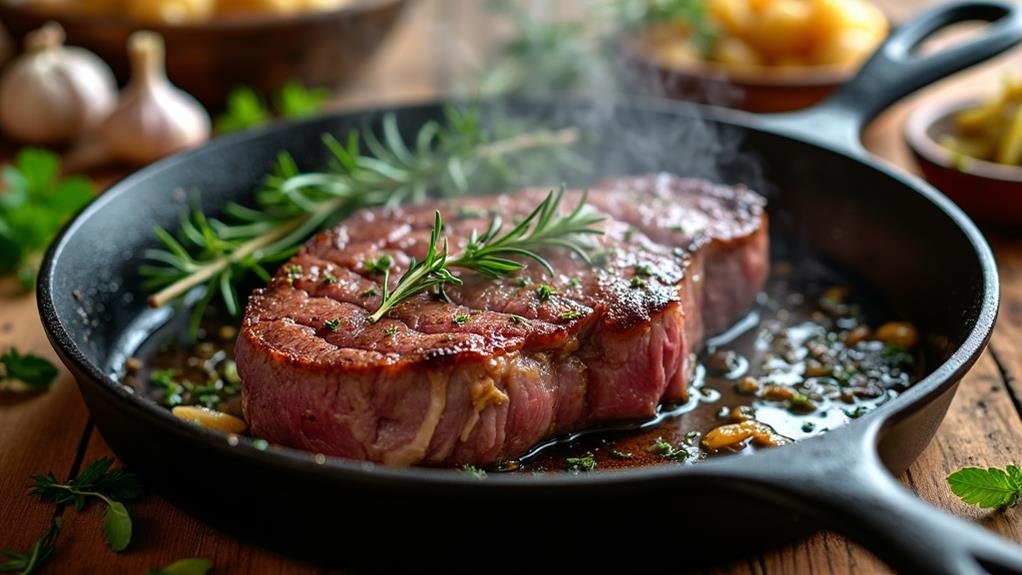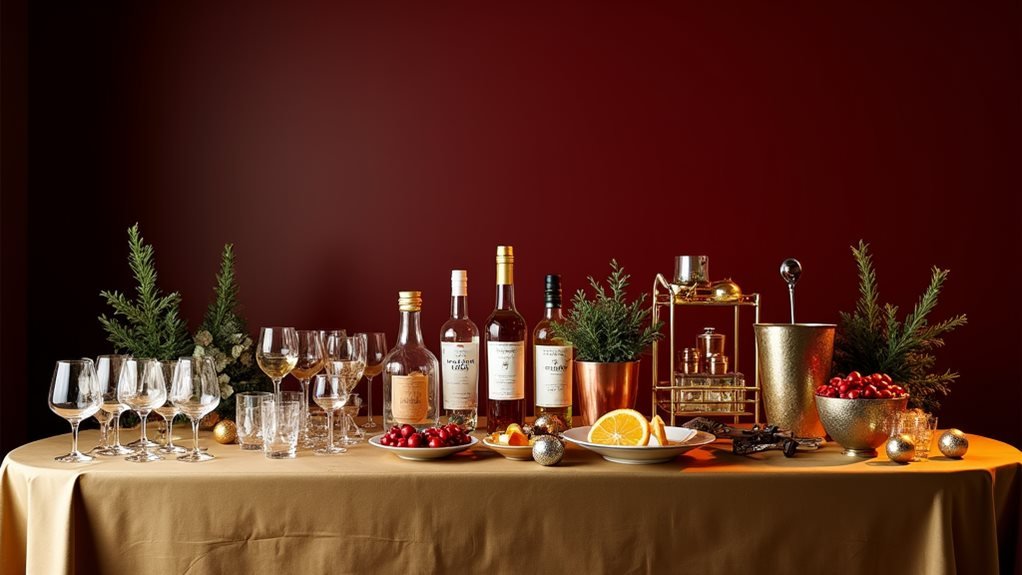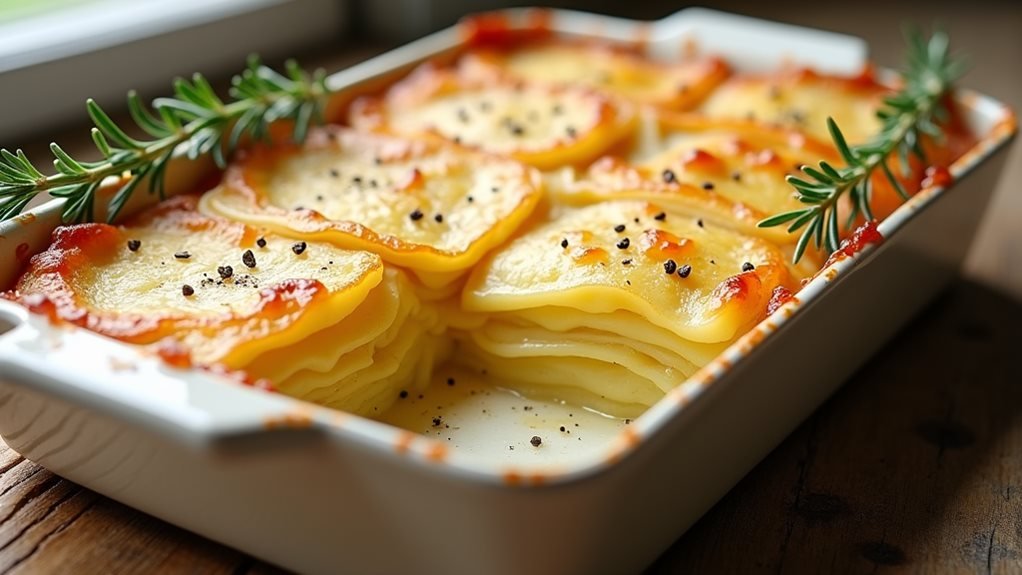To cook steak like Gordon Ramsay, the key is in how you position it in the skillet. Always place the edge of the steak closest to the pan, laying it down in the opposite direction from your body. This prevents hot oil splatters, improving safety. Make sure your skillet is preheated to at least 375°F; high heat is essential for developing a caramelized crust while locking in juices. Flip the steak only once for optimal sear, using stainless steel tongs for better control. Mastering these techniques elevates your culinary confidence and efficiency. There's more to learn, including flavor improvement methods and safety tips.
The Key Cooking Technique
Mastering the essential cooking technique for beef steak is crucial for achieving that high-end restaurant flavor and texture. Celebrity chef Gordon Ramsay highlights the significance of placing the steak away from your body when putting it in the skillet. This straightforward tip helps prevent hot oil from splattering, ensuring your safety while preparing the dish. You should position the edge of the steak nearest to the skillet, laying it down in the opposite direction. This method allows the steak to sear effectively, creating a rich, caramelized crust on one side. Additionally, using a high-quality marinade can significantly enhance the overall flavor, crafting a delectable experience that pairs well with the searing method, as showcased in the top ribeye marinade.
As you cook, tilt the skillet slightly to render the edges, guaranteeing that every section of the steak receives that delightful, uniform cook. The intense heat is vital here; it forms a fierce surface that helps seal in the flavors. Ramsay's technique not only elevates taste but also reduces the chance of a gray edge, which can occur when the steak isn't seared long enough.
Flipping the Steak Correctly

Flipping a steak correctly is essential for achieving the ideal combination of sear and juiciness. When it's time to flip, do it just once to allow one side to develop a beautifully caramelized crust. Start by placing the steak in a cast iron skillet with the edge closest to you. This positioning prevents hot fat from splattering towards you, prioritizing safety. After searing the steak, let it rest undisturbed to lock in those rich flavors. Just like crafting perfect pasta sheets requires focus and patience, so does cooking a steak.
When it's time to flip, use stainless steel tongs for enhanced control. Gently lift the steak and turn it over in one fluid motion. This technique minimizes tearing and ensures that those flavorful juices remain inside. Flipping too frequently can result in uneven cooking, so resist the temptation to check it every few seconds.
Additionally, remember to tilt the skillet away from you to cook the edges. This method not only facilitates the flipping process but also helps render excess fat, enhancing the overall flavor. By mastering the art of flipping, you're on your way to steak perfection, complete with a delectable crust and juicy interior that will impress any guest.
Importance of High Heat

Why is high heat crucial when cooking steak? Achieving the ideal steak relies on the temperature you apply. A scorching surface, ideally at least 375 degrees Fahrenheit, is vital for creating that appetizingly browned crust. This initial searing locks in flavorful juices, ensuring the interior stays tender while the exterior develops a savory layer. Just as the texture in Ghirardelli blondies can vary based on preference, the appropriate heat level can elevate your steak to exceptional heights.
Utilizing a high smoke point oil, like canola oil, is essential for this process. It withstands the heat without burning, providing an even cooking surface. Brushing the steak with oil also minimizes splattering, keeping your cooking area tidy.
When you start with high heat, you're not just cooking; you're crafting a culinary masterpiece. It offers the opportunity to experiment, to achieve that restaurant-quality sear right in your kitchen. Remember, the objective is to caramelize the surface while preserving a juicy interior, and high heat is your best companion in this quest. So, turn up the heat and let the magic unfold. Your steak will express its gratitude.
Benefits of Ramsay's Method

Adopting Gordon Ramsay's culinary technique yields numerous advantages that enhance your steak preparation. Firstly, his approach creates a beautifully caramelized crust. By searing one side before flipping, you lock in flavor and achieve that irresistible texture steak lovers desire. This method also shortens cooking time, allowing you to savor your meal sooner. Additionally, using a well-balanced mix of spices, reminiscent of those found in Ramsay's Indian dishes, can elevate your steak's flavor profile.
Another benefit is the even cooking it encourages. Flipping the steak only once ensures a consistent temperature throughout, eliminating the undesirable gray edge that can spoil a perfect cut. Furthermore, positioning the steak away from you reduces splattering hot fat, making the cooking process safer and more enjoyable.
These cooking techniques not only improve the quality of your steak but also boost your confidence in the kitchen. You'll feel empowered knowing you're employing a method that professional chefs endorse. So, embrace Ramsay's culinary approach, and experience the fulfillment of serving a steak that rivals those from top-tier steakhouses. Enjoy the freedom to cook innovatively, confident that you're on the road to steak perfection.
Safety and Additional Tips

When preparing a ribeye steak, safety and technique are essential for a mouthwatering result. A crucial tip is to position the steak away from your body when placing it in a scorching skillet. This practice significantly reduces the chance of hot oil splattering, which can cause painful burns. Always ensure that the edge of the steak faces the skillet, and lower it down in the opposite direction to maintain control during cooking.
To enhance both flavor and tenderness, marinate your ribeye using a mixture of ingredients like Kikkoman soy sauce and fresh garlic for a minimum of 2 hours. This step is key to achieving a rich taste.
Maintain your skillet at a high temperature—ideally, at least 375 degrees Fahrenheit. This heat is necessary for forming a delicious caramelized crust. Opt for canola oil, known for its high smoke point, and brush it onto the ribeye to minimize splattering. When it comes time to flip the steak, aim to do so only once after searing one side; this technique promotes even cooking and shortens the overall cooking time.
Lastly, remember to sear the edges of the ribeye by tilting the skillet away from you. Use tongs to hold the steak upright, ensuring that every surface cooks thoroughly. By adhering to these safety tips and techniques, you will enhance both your culinary experience and the final dish.








